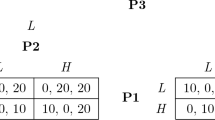Abstract
The class of weakly acyclic games, which includes potential games and dominance-solvable games, captures many practical application domains. In a weakly acyclic game, from any starting state, there is a sequence of better-response moves that leads to a pure Nash equilibrium; informally, these are games in which natural distributed dynamics, such as better-response dynamics, cannot enter inescapable oscillations. We establish a novel link between such games and the existence of pure Nash equilibria in subgames. Specifically, we show that the existence of a unique pure Nash equilibrium in every subgame implies the weak acyclicity of a game. In contrast, the possible existence of multiple pure Nash equilibria in every subgame is insufficient for weak acyclicity in general; here, we also systematically identify the special cases (in terms of the number of players and strategies) for which this is sufficient to guarantee weak acyclicity.





Similar content being viewed by others
Notes
In some of the economics literature, the terms “weak finite-improvement path property” (weak FIP) and “weak finite best-response path property” (weak FBRP) are also used, for weak acyclicity under better- and best-response dynamics, respectively.
For example, this might happen if the link between 2 and d temporarily fails. 2 would always choose to send traffic to 1 (if anywhere); 1 would eventually converge to sending traffic directly to d (with 2 sending its traffic to 1), and 3 would then be able to send its traffic along 321d. Once the failed link between 2 and d is restored, 2’s best response to the choices of the other nodes is to send its traffic directly to d, resulting in the first configuration of the cycle above.
Yamamori and Takahashi use the terms quasi-acyclicity for weak acyclicity under best response, and Pure Nash Equilibrium Property (PNEP) for subgame stability.
Each player has 2 or more strategies.
References
Engelberg, R., Schapira, M.: Weakly-acyclic (Internet) routing games. In: SAGT, pp. 290–301 (2011)
Fabrikant, A., Papadimitriou, C.H.: The complexity of game dynamics: BGP oscillations, sink equilibria, and beyond. In: Proceedings of ACM–SIAM SODA, pp. 844–853 (2008)
Friedman, J.W., Mezzetti, C.: Learning in games by random sampling. J. Econ. Theory 98, 55–84 (2001)
Goemans, M., Mirrokni, V., Vetta, A.: Sink equilibria and convergence. In: Proceedings of IEEE FOCS, pp. 142–151 (2005)
Griffin, T.G., Shepherd, F.B., Wilfong, G.: The stable paths problem and interdomain routing. IEEE/ACM Trans. Netw. 10(2), 232–243 (2002)
Jaggard, A.D., Schapira, M., Wright, R.N.: Distributed computing with adaptive heuristics. In: The Second Symposium on Innovations in Computer Science, pp. 417–443 (2011)
Kukushkin, N.S., Takahashi, S., Yamamori, T.: Improvement dynamics in games with strategic complementarities. Int. J. Game Theory 33(2), 229–238 (2005)
Levin, H., Schapira, M., Zohar, A.: Interdomain routing and games. In: Proceedings of ACM STOC, pp. 57–66 (2008)
Marden, J., Arslan, G., Shamma, J.: Connections between cooperative control and potential games illustrated on the consensus problem. In: Proceedings of the European Control Conference (2007)
Marden, J.R., Young, H.P., Arslan, G., Shamma, J.S.: Payoff-based dynamics in multi-player weakly acyclic games. SIAM J. Control Optim. 48, 373–396 (2009)
Milchtaich, I.: Congestion games with player-specific payoff functions. Games Econ. Behav. 13, 111–124 (1996)
Mirrokni, V.S., Skopalik, A.: On the complexity of Nash dynamics and sink equilibria. In: ACM Conference on Electronic Commerce, pp. 1–10 (2009)
Monderer, D., Shapley, L.S.: Potential games. Games Econ. Behav. 14, 124–143 (1996)
Moulin, H.: Dominance solvable voting schemes. Econometrica 47, 1337–1351 (1979)
Nisan, N., Schapira, M., Zohar, A.: Asynchronous best-reply dynamics. In: Proceedings of the Workshop on Internet Economics, pp. 531–538 (2008)
Rosenthal, R.W.: A class of games possessing pure-strategy Nash equilibria. Int. J. Game Theory 2, 65–67 (1973)
Yamamori, T., Takahashi, S.: The pure Nash equilibrium property and the quasi-acyclic condition. Econ. Bull. 3(22), 1–6 (2002). http://econpapers.repec.org/RePEc:ebl:ecbull:v:3:y:2002:i:22:p:1-6
Young, H.P.: The evolution of conventions. Econometrica 61(1), 57–84 (1993)
Author information
Authors and Affiliations
Corresponding author
Additional information
The first author was supported by a Cisco URP grant and a Princeton University postdoctoral fellowship. The second author was partially supported by NSF grants 0751674, 0753492, and 1101690. The third author was supported by a grant from the Israel Science Foundation (ISF) and by the Marie Curie Career Integration Grant (CIG). This is a revised and expanded version of a paper that appeared in the Proceedings of SAGT 2010.
Rights and permissions
About this article
Cite this article
Fabrikant, A., Jaggard, A.D. & Schapira, M. On the Structure of Weakly Acyclic Games. Theory Comput Syst 53, 107–122 (2013). https://doi.org/10.1007/s00224-013-9457-0
Published:
Issue Date:
DOI: https://doi.org/10.1007/s00224-013-9457-0




